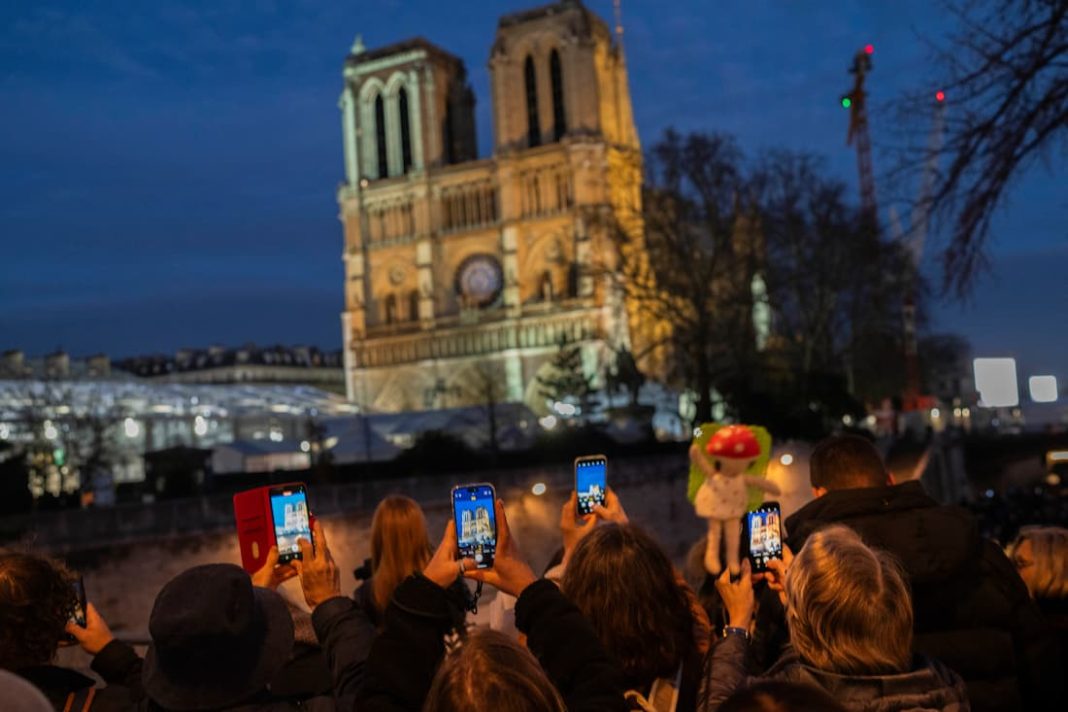Notre Dame Cathedral is reopening its doors in Paris five-and-a-half years after it was ravaged by a devastating fire that destroyed its spire and roof and brought the entire Gothic masterpiece within minutes of collapsing.
The 860-year-old medieval cathedral, a symbol of France and Paris, has been meticulously restored, with a new spire and rib vaulting, its flying buttresses and carved stone gargoyles returned to their past glory and the white stone and gold decorations shining brighter than ever.
On the evening of April 15, 2019, Parisians who rushed to the scene and television viewers worldwide watched with horror as the cathedral’s spire and roof collapsed in the raging fire that threatened the main bell towers – and the entire structure.
“The planet was shaken on that day,” French President Emmanuel Macron said ahead of Saturday’s opening ceremony.
“The shock of the reopening will – I believe and I want to believe – be as strong as that of the fire, but it will be a shock of hope.”
Macron, who is weakened by a deep political crisis at home, will have the chance to forget those woes when he welcomes US President-elect Donald Trump, Britain’s Prince William and dozens of heads of state and government including Ukraine’s President Volodymyr Zelenskiy to a lavish opening ceremony on Saturday from 7pm local time (1800 GMT).
Late on Friday, Macron’s office and the Diocese of Paris said heavy winds would force the celebrations to be held inside the cathedral.
Macron had initially been expected to deliver a speech outside.
“I’m afraid I’ll fall to the ground when I enter because it will be very emotional,” said choir member Cecilia De Vargas, who is due to participate in the opening ceremony.
“Despite the horrible thing that happened, there’s a positive side, seeing how all the people, all the French people, sought to rebuild the cathedral with such speed.”
Thousands of expert craftspeople – from wood carpenters and stonemasons to stained glass window artists – have worked around the clock for the past five years, using age-old methods to restore, repair or replace everything destroyed or damaged.
“Notre Dame is more than a Parisian or French monument,” said historian Damien Berne, a member of the scientific council for the restoration of Notre Dame.
“It’s also a universal monument.
“It’s a landmark, an emblem, a point of reference that reassures in a globalised world where everything evolves permanently.”
The cathedral’s first stone was laid in 1163 and construction continued for much of the next century, with major restoration and additions in the 17th and 18th centuries.
Victor Hugo helped make the cathedral a symbol of both Paris and France when he used it as a setting for his 1831 novel, The Hunchback of Notre Dame.
Quasimodo, the main character, has been portrayed in Hollywood movies, an animated Disney adaptation and musicals.
So much money poured in for the renovation from across the world – more than 840 million euros ($A1.4 billion), according to Macron’s office – that funds remain for further investment in the building.
The Catholic Church expects the restored cathedral to welcome some 15 million visitors annually.
Group visits will be allowed in 2025 – from February 1 for religious groups and from June 9 for tourists with guides.



